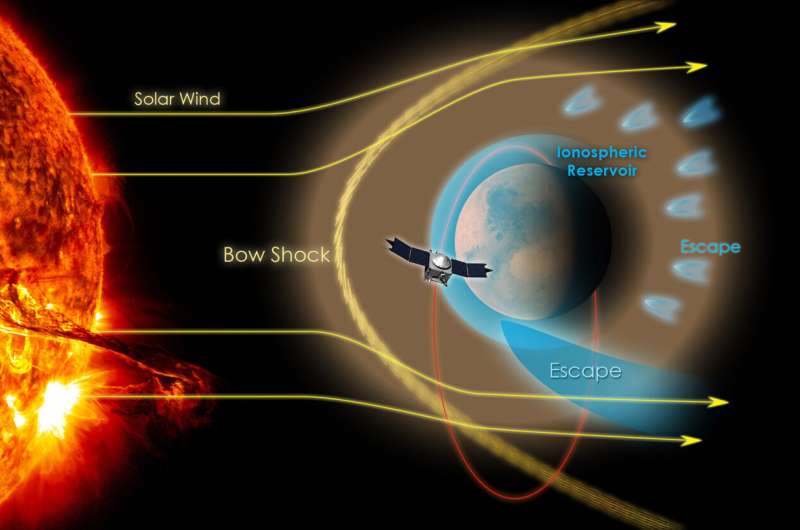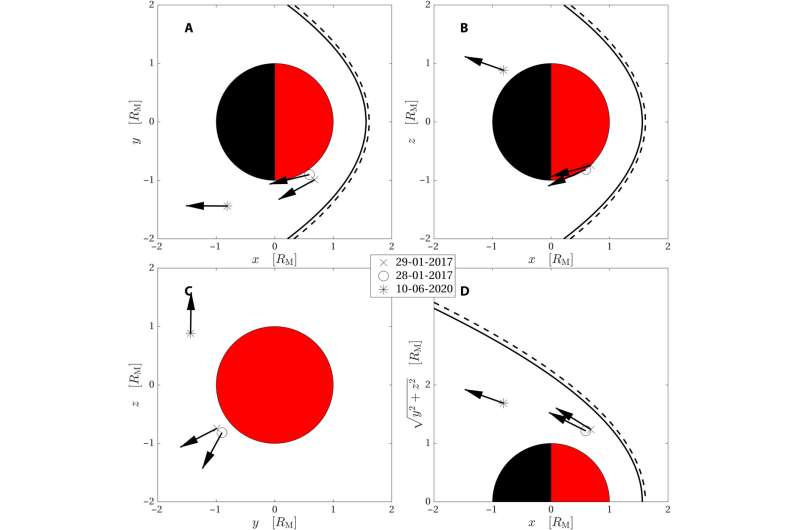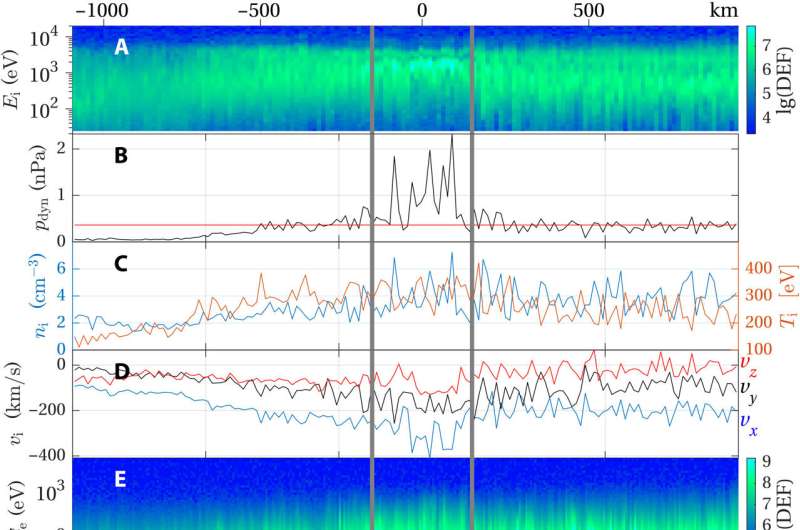June 12, 2023 feature
This article has been reviewed according to Science X's editorial process and policies. Editors have highlighted the following attributes while ensuring the content's credibility:
fact-checked
peer-reviewed publication
trusted source
proofread
Study explores magnetosheath jets on Mars

Magnetosheath jets on Earth are plasma entities that have a higher dynamic pressure surrounding the plasma and can cause waves that transfer energy within such environments. Such jets also exist beyond Earth in the magnetosheath of Mars, as observed by Herbert Gunell and a research team at the Department of Physics, Umea University, and the Swedish Institute of Space Physics, in Sweden, by using the MAVEN spacecraft database. The team's results are now published in Science Advances.
The extraterrestrial counterpart of this Earthly phenomenon comparatively varied on Mars due to its smaller bow shock wave and is associated with increased magnetic field fluctuations such as jets in the solar system to impact the astrophysical plasmas. In this work, the research team incorporated single-spacecraft database-driven analyses to validate the existence of jets in the magnetosheath of Mars.
Mechanism of magnetosheath formation and progression on Earth: Implications for Mars
Astrophysicists had at first assumed the existence of magnetosheath jets only on Earth. However, since all planets have bow shocks, as do some comets, the phenomenon of shock is ubiquitous in astrophysics. In this study, the data obtained by the MAVEN spacecraft provided a clear view of the existence of jets in the magnetosheath of Mars.
When solar winds encounter Earth's magnetic field, the resulting change from supersonic to subsonic flow forms a bow shock wave. Braked solar wind can form a magnetosheath, a compressed region with heated plasma. Magnetosheath jets occur via the dynamic presentation of pressure in the plasma that result from an increased density and/or velocity on Earth. Astrophysicists initially studied the movement of jets across magnetic fields in the lab using a vacuum with background plasmas to engineer plasmoids. Researchers first reported the phenomenon on Earth in the late 1990s, which has now resulted in a substantial body of work.

Jets can generate waves in the magnetosheath to cause surface waves and the emission of Alfvén waves detected by ground-based magnetometers. The concept is also associated with a phenomenon known as throat auroras. Most mechanisms of bow shock formation and magnetosheath production suggest interactions of solar winds with ripples on the bow shock, relative to Short Large Amplitude Magnetic Structures (SLAMS), or hot flow anomalies, and bow shock reformation. Jets are integral to downscaling the bow shock in the magnetosheath, and to transfer solar wind energy to wave energy across the plasma environment.
MAVEN spacecraft data analysis
Gunell and colleagues presented three examples of jets observed by the MAVEN spacecraft on January 28 and January 29, 2017, as well as on June 10, 2020. During the initial timeline of observation, the team projected spacecraft positions onto the principal planes of the Mars solar orbital coordinate system. They schematically presented the outcome with dashed and solid lines to show a model bow shock in the study. During subsequent analyses, the spacecraft did not enter solar wind; the parameters of the second timeframe were therefore estimated from measurements in the magnetosheath.

The ion spectrum obtained from the database showed many protons and alpha particle populations. The alpha particles took longer to undergo thermalization after passing through the bow shock compared to protons due to their larger gyroradius. The team further examined the comparative proximity of the magnetosheath jets to planet Mars on the two timeframes in 2017 and 2020 to show that the phenomenon was closer to the planet at the earlier timeframe than the latter, as encountered and documented by the MAVEN spacecraft.
The evolution of a bow shock
By June 10, 2020, the team observed the jet magnetosheath to occur further downstream and at a higher altitude. They noted two pulses of increased dynamic pressure and the longer distance of the bow shock resulted in a mixture of alpha particles and protons instead of appearing as distinct populations. The enhanced dynamic pressure of the scenario depended on an increased density, where magnetic field fluctuations showed higher amplitude inside the jets.
The astrophysicists continued to monitor the bow shock and interplanetary magnetic field. The single-spacecraft study revealed a simple estimation of the jet size. Gunell and colleagues compared the jet size to the magnetosheath scale to arrive at conclusions about the shape of the jet and its origin. For instance, they recorded a jet size in the range of 4000–18,000 km in the direction of ion velocity a scale much greater than the distance traveled by the observatory spacecraft.
Outlook
In this way, Herbert Gunell and colleagues showed how the ubiquitous and geoeffective phenomena of magnetosheath jets on Earth can generate waves and transfer energy within the magnetosheath. While such phenomena exist beyond Earth's atmosphere on a Martian magnetosphere at a different scale and character, they play similar roles on both planetary environments.
The researchers propose employing larger statistical studies in the future for the quantitative estimation of the geo-effectiveness of magnetosheath jets on Mars suited for diverse solar wind conditions to cover all regions of space around the planet.
More information:
Herbert Gunell et al, Magnetosheath jets at Mars, Science Advances (2023). DOI: 10.1126/sciadv.adg5703
M. O. Archer et al, Direct observations of a surface eigenmode of the dayside magnetopause, Nature Communications (2019). DOI: 10.1038/s41467-018-08134-5
Journal information: Nature Communications , Science Advances
© 2023 Science X Network





















